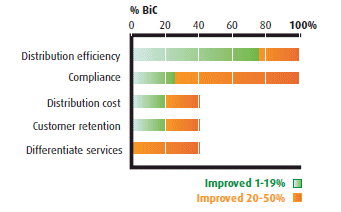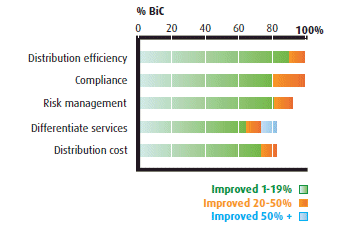Business Benefits of GSCM Practices
Best–in–Class (BiC) firms are defined as businesses that achieve positive environmental improvements in the two main GSCM practices specific to the firms' sector. For retail chains and CPG logistics and transportation service providers, these two main improvements are reduced energy consumption and decreased waste in distribution activities. For CPG manufacturers, the main improvements are energy reduction and decreased packaging in distribution activities.1
BiC retail chains are increasingly more efficient in their distribution activities and have enhanced compliance processes. Compliance of retail chains refers to their conformity to recycling and packaging regulations as well as to how they meet and respond to corporate objectives.2 Seventy–five percent of BiC retail chainsreport an improvement in compliance of 20–50 percent. Forty percent have improved customer retention, reduced distribution cost, and increased service differentiation (Figure 8). It is also important to note that those retail chains that have implemented GSCM mandates with their suppliers are achieving a performance that is at least 20 percent higher than those without GSCM mandates (improving in terms of distribution cost reduction, compliance and distribution efficiency).1
Figure 8: Business benefits — BiC retail chains 1

As in the case of retail chains, BiC CPG manufacturers are also gaining business benefits through improved compliance processes and greater distribution efficiency. Distribution efficiency is defined as having the right product distributed to the right place, at the right time, and at the right cost. Also, at least 80 percent of BiCCPG manufacturers are experiencing a 1–19 percent improvement in risk management, distribution cost, and product differentiation (Figure 9).
Figure 9: Business benefits — BiC CPG manufacturers1

Many CPG manufacturers take responsibility for product quality/reliability throughout the entire service life of a product, including product distribution and reverse logistics. Reverse logistics refers to all operationsrelated to reusing products and materials. It is the process of planning, implementing, and controllingthe efficient and cost–effective flow of raw materials, in–process inventory, finished goods, and relatedinformation from the point of consumption to the point of origin for the purpose of recapturing value or properlydisposing of a product. By reducing uncertainties related to the distribution of goods, CPG manufacturers have opportunities to contain distribution cost and lessen their global risks and environmental footprint at the same time.2
Over 80 percent of BiC CPG logistics and transportation service providers have gained significantly in terms of improved distribution efficiency, reduced distribution cost, and increased service differentiation. Also, over40 percent of them have experienced 20–50 percent improvements in compliance processes and customer retention (Figure 10).
Figure 10: Business benefits — BiC CPG logistics and transportation service providers1

